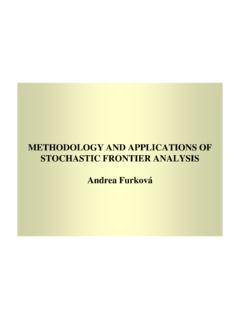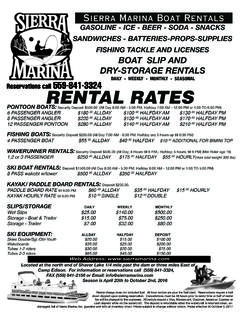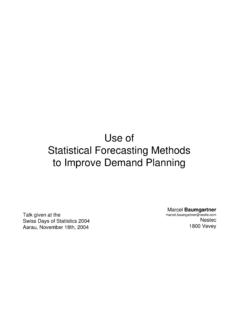Transcription of Overview of Economic Forecasting Methods - f hi
1 1 Overview of Economic Forecasting Methods : Forecasting Techniques Causal Methods Time Series Methods Qualitative Methods Regression Analysis Multiple Regression Moving Average Exponential Smoothing Trend & seasonal Decomposit ion Delphi Method Jury of Executive Opinion Sales Force Composite Consumer Market Survey Box-Jenkins ARIMA Qualitative Regression Logit, Probit 2a. Causal (Multivariate) Forecasting Methods : Regression Methods Make projections of the future by modeling the causal relationship between a series and other series. Can use time series or cross-sectional data to forecast. Yt = f (Xt) or Yt = f (X1t, .., Xkt, Y2t, ..,Y1k) Methods : Simple or Multiple models System equation models Seeming unrelated models b. Univariate Forecasting Methods or Time series Methods Using the past, internal patterns in data to forecast the future.
2 Yt+1 = f (Yt, Yt-1, Yt-2, Yt-3) Methods : Moving average Smoothing and Exponential smoothing Decomposition: seasonal and trend decomposition ARIMA (box-Jenkins) c. Multivariate Time series Methods Y1t = f (Y1,t-1, .., Y2,t, ..,Yj,t, .., X1,t,.., Xj,t-k) Methods : Multivariate ARIMA models Autoregressive and distributed-lag models Vector Autoregression (VAR) Vector Error Correction (VEC) models ARCH and GARCH models d. Qualitative Forecasting Methods : Dummy variables are used to characterize the information that choices are involved. Such data is referred to as qualitative data. Models including yes-no-type as dependent variables are called dichotomous, or dummy dependent variable regression models. There are three approaches to estimating and Forecasting such models; (1) Linear Probability model (LPM), (2) Logit model, (3) Probit model and Tobit model.
3 Other qualitative Forecasting Methods are based on the judgement and opinions of others, such as concerning future trends, tastes and technological changes. Qualitative Methods include Delphi, market research, panel consensus, scenario analysis, and historical analogy Methods of predicting the future. Qualitative Methods are useful when there is little data to support quantitative Methods . 3 Understanding the classifications of Economic data: 1. Primary versus secondary data: The first hand data are called primary data: In natural sciences, the bulk of data are generated by running experiments in a laboratory under a controlled environment in which factors are determined by the researchers according to their theoretical design. Therefore, the quality of data is very often control by the researchers. In social sciences, particular in economics, researchers cannot create their own data by running experiments in a laboratory.
4 They must rely on the data collected by official or agencies. Data collected by another party are called secondary data. If the data do not meet the desired standard of quality, social scientists cannot afford to throw them away. Instead, they must patiently and carefully treat or adjust these data by means of different econometrics and statistical Methods . 2. Time-Series versus cross-sectional data Time series is a collection of observations generated sequentially through time. Time series data can be observed at many "frequencies". The common frequencies of Economic data are annual, quarterly, monthly , weekly, and daily. The minute-by-minute and even the second-by-second data are also very commonly used in the financial researches. Cross-sectional data are observations generated from different Economic units in a given time period. These units might refer to firms, factors, groups, people, areas, provinces, regions, or countries, etc.
5 Panel (or pooled) data combines the time-series and cross-sectional approaches. 3. Macroeconomic versus microeconomic data Highly aggregated data that measure the activity in the economy as a whole, such as GDP, implicit price deflator, interest rate, unemployment rate, money supply, etc., are called macroeconomic data. Disaggregated data that measures the Economic activity of an individual household, factor, firm, or industry are called microeconomic data. 4. High-frequency versus low-frequency data Most Economic data are collected over a discrete interval of time. The length of the discrete interval classifies measurements into annual, semiannual, quarterly, monthly , weekly, or daily data. Data collected over longer intervals are released less frequently, this type of data is called low-frequency data. Hourly, daily or weekly data is called more high-frequency data. Real-time data is the data reflect events at the moments, all others are called historical data.
6 5. Quantitative versus qualitative data The Economic data have a number corresponding to each Economic unit, described as previous data sets, is referred to as quantitative data. When we want to characterize a series of information such "yes" or "no", "good" or "bad", "male" or female", or others. These data information is referred to qualitative data. Such data arise often in economics when choices are involved. When we convert these qualitative 4characteristics into numeric data, we might assign 1 = "yes" and 0 = "no". When a variable take on only the numeric values 1 and zero, they are referred to as dummy (or binary) variables. Measurement and conversion of Economic data 1. Economic variable measured as levels Flow variable: data flows overtime as a stream. Stock variable: a measurement at a particular point of time and is the accumulation of all past flows.
7 For example, investment in a given year is a flow variable, and the capital stock is a stock variable. 2. Economic variables measured as indexes Index is the series data based on a particular based period (notation with subscription 0) or reference period, the levels of the variable in other time periods (notation with subscript with t) are compared with the based-period level and measured. An Economic indicator measured as an index must have a known base period to show relative magnitude. Without a base period, the index itself is not meaningful. There are two example types of price indexes Laspeyres index of t period = 100* PtQ0 / P0Q0 (Base-weighted index) Paasche index of t period = 100* PtQt / P0Qt (Current-weighted index) Effective exchange rate index = wiEi (Where wi is the weight) Real exchange rate index = E(HK$/US$) x (US Price index/ HK Price index) Others such as production index, and wage index, etc are measured in index.
8 3. Economic variables measures as growth rates and ratios Economic variables measured in term of percentage change or ratios are derived from level or index variable. For examples: Growth rate = 100*(GDPt GDPt-1)/GDPt-1 Inflation rate = 100* (CPIt CPIt-1)CPIt-1 Unemployment rate = 100* (Labor force Employment)/Labor force Exchange rate = Domestic currency (units value)/ foreign currency (unit value) In many instances, management finds forecasted growth rate of an Economic variables to be of more interest than forecast of absolute levels. Growth rate conversions tend to focus attention on marginal changes rather than absolute level. This type of transformation is specifically useful when we are developing forecasts with multiple Economic variables measured in different units. For example: if we want to generate a forecast for interest rates (measured in 5percentage term), one of the factors that we might consider would be the money supply (record in billions of dollars).
9 Therefore, it is more useful to convert the money supply data to a percentage growth format similar with the interest rates. 4. Linear Transformation Linear transformations are specifically useful when applying regression analysis to Forecasting problems. Specifically, regression analysis begins by assuming that the relationship between variables is linear. The advantage of this type of conversion is that we have been able to take a relationship that does not satisfy the requirements of linearity and transform the data. The two common Methods are: - logarithmic transformation - square root transformation Eight Steps of Forecasting 1. Determine the use of the forecast what objective are you trying to obtain? 2. Select the items or quantities that are to be forecasted. 3. Determine the time horizon of the forecast is it short term (1-30 days), medium term (one month to one year), or long term (more than one year).
10 4. Select the Forecasting method or model(s). 5. Gather the data needed to make the forecast 6. Validate the Forecasting model 7. Make the forecast. 8. Implement the results. 6 Understand the common patterns of Time series: When a time series is plotted, common patterns are frequently found. These patterns might be explained by many possible cause-and-effect relationships. Random patterns: Random time series are the result of many influences that act independently to yield nonsystematic and non-repeating patterns about some average value. Purely random series have a constant mean and no systematic patterns. Simply averaging model are often the most best and accurate way to forecast them. Trend patterns: A trend is a general increase or decrease in a time series that lasts for approximately seven or more periods. A trend can be a period-to-period increase or decrease that follows as a straight-line, this kind of pattern is called a linear trend.








